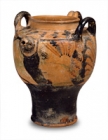Asian Gallery (Toyokan) Room 10
April 25, 2006 (Tue) - July 17, 2006 (Mon)
The Etruscans were active in central Italy while Rome was still a small city-state. They created the Etruscan Dodecapoli, a league of twelve powerful cities whose influence stretched from the Po River valley in the north to Campania in the south. Blessed with rich mineral resources, they produced wine and oils on the fertile soil. In addition to appreciating Greek culture, they also had relations with the Phoenicians of Carthage, which was located along the Mediterranean on the Northern Coast of Africa.
The Etruscans gradually reversed their position of authority with Rome, who they had controlled at one time. When Rome fought against Carthage and the Celts, the Etruscans fought on the side of the Romans. However, while their government had lost its independence, the unique Etruscan culture continued to flourish until the 1st century BC.
The ceramics in this exhibit were donated to the museum by the National Museum of Eastern Art in Italy. This display starts with funereal urns from the Villanovan culture - the predecessor to the Etruscans - and moves to Greek-influenced pottery. It continues with the independently developed burnished black bucchero ware, and finishes with the Etruscans view of life and death as expressed through votive objects and cinerary urns. We hope that you enjoy learning about the Etruscans through their ceramics.

